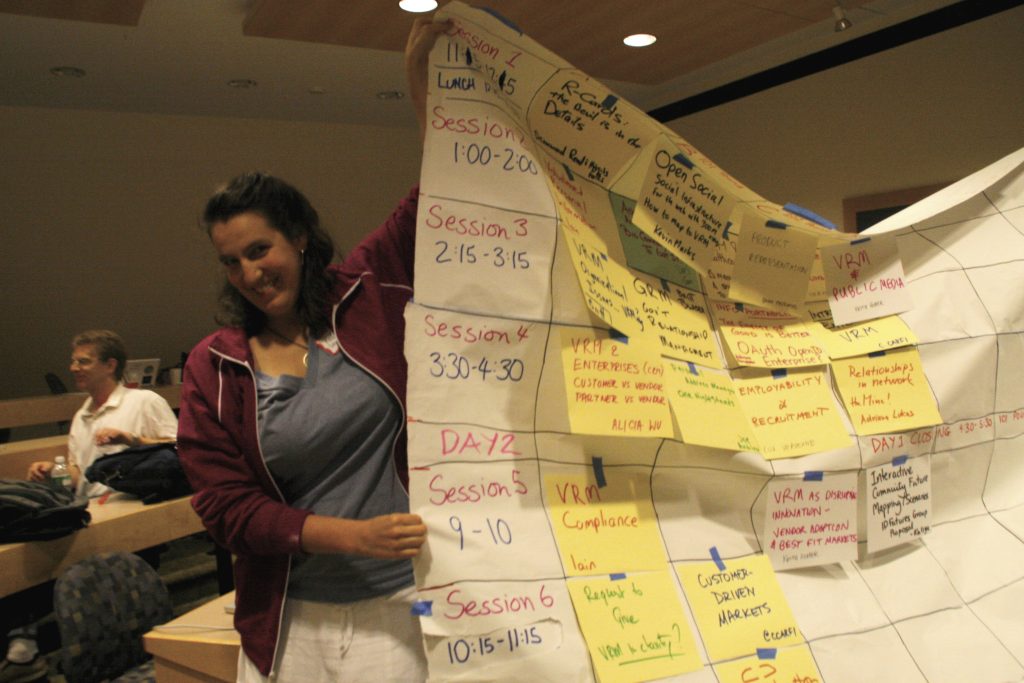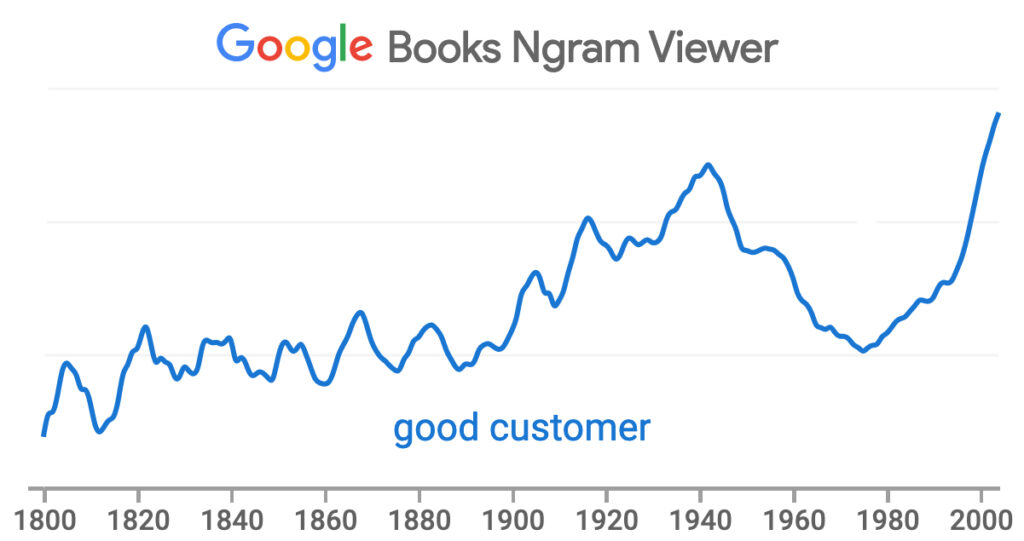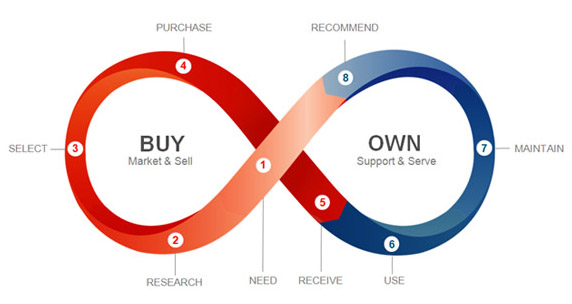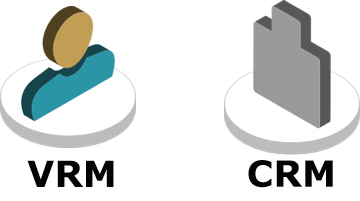A friend pointed me to this video of a slide presentation by Bixy, because it looked to him kinda like VRM. I thought so too…. at first. Here’s an image from the deck:

Here is what I wrote back, updated and improved a bit:
These are my notes on slides within the deck/video.
1) It looks to me like a CRM refresh rather than VRM. There have been many of these. And, while Bixy looks better than any others I can remember (partly because I can’t remember any… it’s all a blur), it’s still pitching into the CRM market. Nothing wrong with that: it’s a huge market, with side categories all around it. It’s just not VRM, which is the customer hand CRM shakes. (And no, a CRM system giving the customer a hand to shake the CRM’s with isn’t VRM. It’s just gravy on a loyalty card.)
2) The notion that customers (I dislike the word “consumers”) want relationships with brands is a sell-side fantasy. Mostly customers are looking to buy something they’ve already searched for, or to keep what they already own working, or to replace one thing with another that won’t fail—and to get decent service when something does fail. (For more on this subject, I suggest reading the great Bob Hoffman, for example here.)
3) While it’s true that customers don’t want to be tracked, annoyed and manipulated, and that those practices have led to dislike of businesses and icky legislation (bulls eye on all of those), and that “relationships are based on trust, value, attention, respect and communication,” none of those five things mean much to the customer if all of them are locked into a company’s one-to-many system, which is what we have with 100% of all CRM, CX and XX (pick your initialism) systems—all of them different, which means a customer needs to have as many different ways to trust, value, attend to, respect and communicate as there are company systems for providing the means.
4) Bixy’s idea here (and what the graphic above suggests, is that the customer can express likes and dislikes to many Brands’ Salesforce CRM systems. They call this “sharing for value in return.” But there is far appetite for this than than marketing thinks. Customers share as little as they can when they are fully required to do so, and would rather share zero when they go about their ordinary surfing online or shopping anywhere. Worse, marketing in general (follow the news)—and adtech/martech in particular—continue to believe that customers “share” data gathered about them by surveillance, and that this is “exchanged” for free services, discounts and other goodies. This is one of the worst rationalizations in the history of business.
5) “B2C conversations” that are “transparent, personalized and informative” is more a marketing fantasy than a customer desire. What customers would desire, if they were available, are tools that enhance them with superpowers. For example, the power to change their last name, email address or credit card for every company they deal with, in one move. This is real scale: customer scale. We call these superpowers customertech:

CRM is vendortech.
6) Some percentage of Adidas customers (the example in that video) may be willing to fill out a “conversational” form to arrive at a shoe purchase, but I suspect a far larger percentage would regard the whole exercise as a privacy-risking journey down a sales funnel that they’d rather not be in. So long as the world lacks standard ways for people to prevent surveillance of their private spaces and harvesting of personal data, to make non-coercive two-way agreements with others, and ways to monitor person data use and agreement compliance, there is no way trustworthy “conversations” of the kind Bixy proposes can happen.
7) Incumbent “loyalty” programs are, on the whole, expensive and absurd.
Take Peet’s Coffee, a brand I actually do love. I’ve been a customer of Peet’s for, let’s see… 35 years. I have a high-end (like in a coffee shop) espresso machine at my house, with a high-end grinder to match. All I want from Peet’s here at home are two kinds of Peet’s beans: Garuda and Major Dickason Decaf. That’s it. I’ve sampled countless single-origin beans and blends from many sources, and those are my faves. I used to buy one-pound bags of those at Peet’s stores; but in COVID time I subscribe to have those delivered. Which isn’t easy, because Peet’s has made buying coffee online remarkably hard. Rather than just showing me all the coffees they have, they want to drag me every time through a “conversational” discovery process—and that’s after the customary (for every company) popover pitch to sign up as a member, which I already am, and to detour through a login-fail password-recovery ditch (with CAPTCHAs, over and over, clicking on busses and traffic lights and crosswalks) that show up every. damn. time. On arrival at the membership home page, “My Dashboard” all but covers the home screen, and tells me I’m 8 points away from my next reward (always a free coffee, which is not worth the trouble, and not why I’m loyal). Under the Shop menu (the only one I might care about) there are no lists of coffee types. Instead there’s “Find Your Match,” which features two kinds of coffee I don’t want and a “take your quiz” game. Below that are “signature blends” that list nothing of ingredients but require one to “Find My Coffee” through a “flavor wheel” that gives one a choice of five flavors (“herbal/earthy,” “bright/citrus”…). I have to go waaay the hell down a well of unwanted and distracting choices to get to the damn actual coffee I know I like.
My point: here is a company that is truly loved (or hell, at least liked) by its customers, mostly because it’s better than Starbucks. They’re in a seller’s market. They don’t need a loyalty program, or the high operational and cognitive overhead involved (e.g. “checking in” at stores with a QR code on a phone app). They could make shopping online a lot simpler with a nice list of products and prices. But instead they decided, typically (for marketing), that they needed all this bullshit to suck customers down sales funnels. When they don’t. If Peet’s dumped its app and made their website and subscription system simpler, they wouldn’t lose one customer and they’d save piles of money.
Now, back to the Adidas example. I am sure anybody who plays sports or runs, or does anything in athletic shoes, would rather just freaking shop for shoes than be led by a robot through a conversational maze that more than likely will lead to a product the company is eager to sell instead of one the customer would rather buy.
7) I think most customers would be creeped to reveal how much they like to run and other stuff like that, when they have no idea how that data will be used—which is also still the typical “experience” online. Please: just show them the shoes, say what they’re made of, what they’re good for, and (if it matters) what celeb jocks like them or have co-branded them.
8) The “value exchange” that fully matters is money for goods. “Relationship” beyond that is largely a matter of reputation and appreciation, which is earned by the products and services themselves, and by human engagement. Not by marketing BS.
8) Bixy’s pitch about “90% of conversation” occurring “outside the app as digital widgets via publisher and marketer SDKs” and “omnichannel personalization” through “buy rewards, affiliate marketing, marketer insights, CRM & CDP, email, ads, loyalty, eCommerce personalization, brand & retailer apps and direct mail” is just more of the half-roboticized marketing world we have, only worse. (It also appears to require the kind of tracking the video says up front that customers don’t want.)
9) The thought of “licensing my personal information to brands for additional royalties and personalization” also creeps me out.
10) I don’t think this is “building relationships from the consumer point of view.” I think it’s a projection of marketing fantasy on a kind of customer that mostly doesn’t exist. I also don’t think “reducing the sales cycle” is any customer’s fantasy.
To sum up, I don’t mean to be harsh. In fact I’m glad to talk with Bixy if they’re interested in helping with what we’re trying to do here at ProjectVRM—or at Customer Commons, the Me2B Alliance and MyData.
I also don’t think Cluetrain‘s first thesis (“Markets are conversations“) can be proven by tools offered only by sellers and made mostly to work for sellers. If we want real market conversations, we need to look at solving market problems from the customers’ side. Look here and here for ways to do that.




















